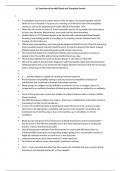Lecture notes
overview of the NHS blood and transplant service
- Module
- Clinical science
- Institution
- Aston University, Birmingham (Aston)
preview:• They are unusual in that the natural occurring antibodies occur in the plasma of subjects who lack the corresponding antigen even if they’ve never been transfused or been pregnant. • The most important of these are anti-A and anti-B, they are usually IgM and react optimally at cold...
[Show more]



